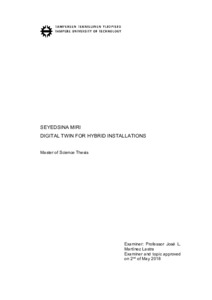Digital Twin for Hybrid Installations
Miri, Seyedsina (2018)
Miri, Seyedsina
2018
Automation Engineering
Teknisten tieteiden tiedekunta - Faculty of Engineering Sciences
This publication is copyrighted. You may download, display and print it for Your own personal use. Commercial use is prohibited.
Hyväksymispäivämäärä
2018-10-03
Julkaisun pysyvä osoite on
https://urn.fi/URN:NBN:fi:tty-201809122285
https://urn.fi/URN:NBN:fi:tty-201809122285
Tiivistelmä
The product development and lifecycle management is constantly affected by digitalization. The same trend has been also observed in the simulation technology. The system simulation has evolved from applications with limited and specific use cases to more standardized and multi-disciplinary tools. The “Digital Twin” concept is the most recent advancement in this field where its definition is beyond a simulator. The concept arose from the “Industry 4.0” development and it can be described as a bi-directional communication between physical products data and their digital representation in the entire product lifecycle.
A hybrid power module consists of components such as an engine, a gearbox, the generator sets, the batteries, and technologies for efficiently exploiting the mechanical energy form the engine and the electrical energy from the batteries. The modular product development necessitates adoption of systems engineering approaches and principles in order to handle the product lifecycle management appropriately. Handling the product lifecycle management for the hybrid power modules encompasses the integration of disengaged elements, data, and stakeholders throughout the product development.
In order to address the abovementioned problem, model-based systems engineering approach incorporates available tools and technologies. A product lifecycle management platform and tools in hand like web services and functional mock-up interface justify the development of a digital twin application. This application must be able to reveal the adoption of system of systems view for hybrid power module development. This can be achieved by creating a reference system model and continuously enriching it with the product lifecycle data. To begin with the implementation of a digital twin application, systems engineering theories are studied, a software development lifecycle is chosen, prototypes of the application, and development technologies are selected. Lastly, the application is programmed and deployed.
The digital twin application is embedded inside a product lifecycle management platform and exploits other resources and data alongside. The application is a simplified implementation of the “V” lifecycle model in systems engineering and achieves objectives like task-centered product development, value co-creation in business processes, product data management, simulation-based, and requirements validation among others.
A hybrid power module consists of components such as an engine, a gearbox, the generator sets, the batteries, and technologies for efficiently exploiting the mechanical energy form the engine and the electrical energy from the batteries. The modular product development necessitates adoption of systems engineering approaches and principles in order to handle the product lifecycle management appropriately. Handling the product lifecycle management for the hybrid power modules encompasses the integration of disengaged elements, data, and stakeholders throughout the product development.
In order to address the abovementioned problem, model-based systems engineering approach incorporates available tools and technologies. A product lifecycle management platform and tools in hand like web services and functional mock-up interface justify the development of a digital twin application. This application must be able to reveal the adoption of system of systems view for hybrid power module development. This can be achieved by creating a reference system model and continuously enriching it with the product lifecycle data. To begin with the implementation of a digital twin application, systems engineering theories are studied, a software development lifecycle is chosen, prototypes of the application, and development technologies are selected. Lastly, the application is programmed and deployed.
The digital twin application is embedded inside a product lifecycle management platform and exploits other resources and data alongside. The application is a simplified implementation of the “V” lifecycle model in systems engineering and achieves objectives like task-centered product development, value co-creation in business processes, product data management, simulation-based, and requirements validation among others.
